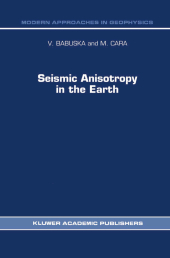 Neuerscheinungen 2012Stand: 2020-01-07 |
Schnellsuche
ISBN/Stichwort/Autor
|
Herderstraße 10
10625 Berlin
Tel.: 030 315 714 16
Fax 030 315 714 14
info@buchspektrum.de |

V. Babuska, M Cara
(Beteiligte)
Seismic Anisotropy in the Earth
2012. viii, 219 S. VIII, 219 p. 235 mm
Verlag/Jahr: SPRINGER NETHERLANDS 2012
ISBN: 9401055963 (9401055963)
Neue ISBN: 978-9401055963 (9789401055963)
Preis und Lieferzeit: Bitte klicken
Structural geologists are well aware of the fact that isotropic rocks are quite exceptional in nature. Whicheverorigin, sedimentary,metamorphicormagmatic, rocks are shaped with a plane of mineral flattening, the foliation in geologists´ jargon, and with a line ofmineral elongation, the lineation. Just like a good quarryman, a trained structural geologistwill detectapreferredorientationin an apparently isotropic granite. Preferred mineral orientation and thus structural anisotropy are the rule in nature. Consideringthe largevariationsinelasticcoefficientsofrock-forming minerals,itcould be predicted that, in turn, seismic anisotropy should exist and be important, provided thatdomains withasimilarstructural signatureare largeenough to affectseismic waves. This is why, in 1982 at a conference held in Frankfurt, which was oneofthe fIrst meetings devoted to the subject of seismic anisotropy, I asked Don Anderson the question of why seismologists had not considered earlier in their models the obvious constraint of anisotropy. I still remember Don´s answer: "Adolphe, we knew that our isotropic models were not very good but we had no other choice. It is simply that, so far, computerswere not largeenough tointegrate the anisotropy parameter". Changingisotropic glassesfor anisotropic ones permits us to obtain betterand more realistic seismic modelsofthe Earth´s interior, but, maybe more importantly, it has, for a seismologist, the farreaching consequenceofsteppinginto the fIeld ofgeodynamics.
1 Introduction.- 2 Seismic-Wave Propagation in Anisotropic Media.- 2.1 A simple anisotropic medium: the stack of isotropic layers.- 2.2 Elastic tensors in general anisotropic media.- 2.3 Plane waves in homogeneous anisotropic media.- 2.3.1 Hexagonal symmetry case.- 2.3.2 Phase and group velocities.- 2.3.3 Perturbation theory.- 2.4 Body waves in heterogeneous anisotropic media.- 2.4.1 Ray theory.- 2.4.2 Computational problems.- 2.4.3 Concluding remarks.- 2.5 Surface waves in anisotropic media.- 2.5.1 Love and Rayleigh waves.- 2.5.2 Love/Rayleigh-wave incompatibility.- 2.5.3 Perturbation theory.- 2.5.4 Concluding remarks.- 3 Elastic Anisotropy of Rock-Forming Minerals and Polycrystalline RockS.- 3.1 Methods of investigation.- 3.2 Velocity anisotropy in rock-forming minerals.- 3.3 Elastic anisotropy of polycrystalline aggregates.- 3.3.1 Effects of cracks and grain boundaries.- 3.3.2 Effects of preferred mineral orientation.- 3.4 Crustal rocks.- 3.5 Uppermost mantle rocks.- 4 Interpretation of Seismic Data in Terms of Anisotropy.- 4.1 Trade-off between seismic anisotropy and heterogeneity.- 4.2 Seismic anisotropy and inverse methods.- 4.3 Interpretation of body-wave data.- 4.3.1 Refraction data.- 4.3.2 Shear-wave splitting.- 4.4 Long-range refraction profiles.- 4.5 Interpretation of surface-wave data.- 5 Anisotropic Structures in the Lithosphere.- 5.1 Oceanic crust.- 5.2 Subcrustal lithosphere under oceans.- 5.2.1 Observations.- 5.2.2 Causes and origin of anisotropy.- 5.2.3 Depth range of anisotropy in the oceanic lithosphere.- 5.3 Subduction zones.- 5.4 Continental crust.- 5.4.1 Upper crust.- 5.4.2 Lower crust.- 5.5 Subcrustal lithosphere of continents.- 5.5.1 Observations.- 5.5.2 Petrological constraints for interpretations.- 5.5.3 Anisotropie models.- 6 Anisotropy in Deeper Parts of the Earth.- 6.1 Asthenosphere.- 6.1.1 The depth extent of large-scale anisotropy.- 6.1.2 Transversely isotropic models.- 6.1.3 Azimuthal anisotropy.- 6.1.4 Possible causes of seismic anisotropy in the asthenosphere.- 6.2 Seismic anisotropy at greater depths.- 6.2.1 Upper-mantle transition region and lower mantle.- 6.2.2 Core-mantle boundary.- 6.2.3 Inner core.- 7 Conclusions and Outlook.- 7.1 Possible causes of the observed seismic anisotropy.- 7.2 Outlook.- References.


